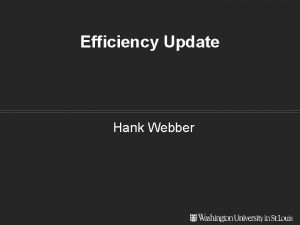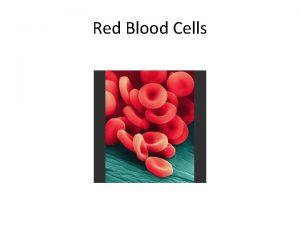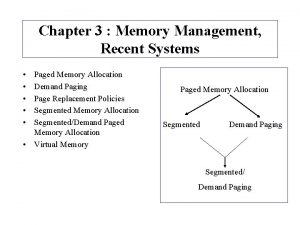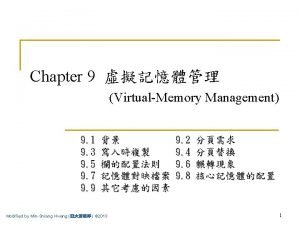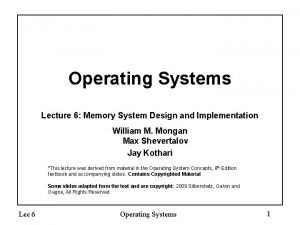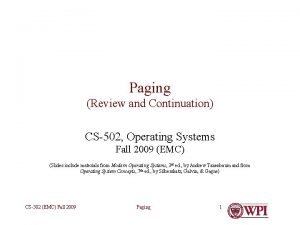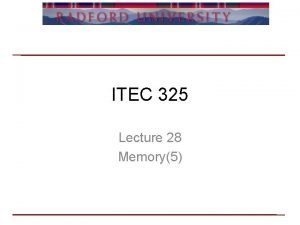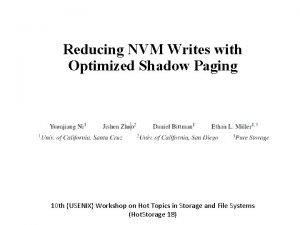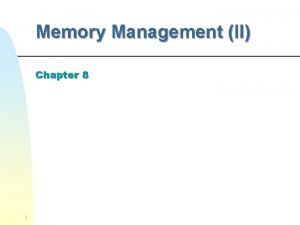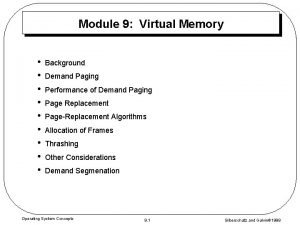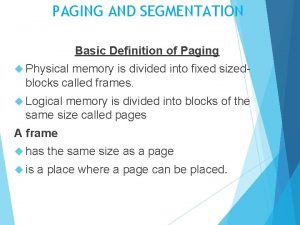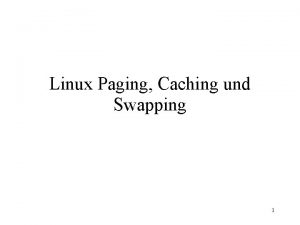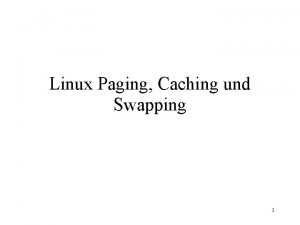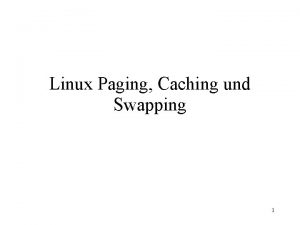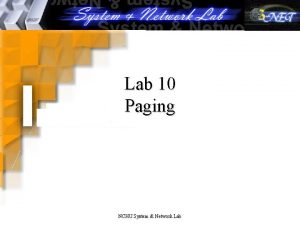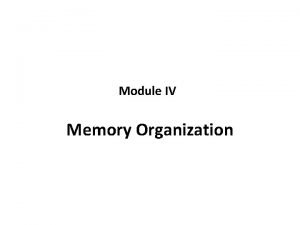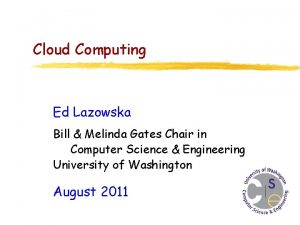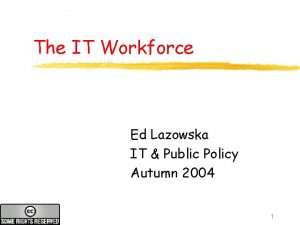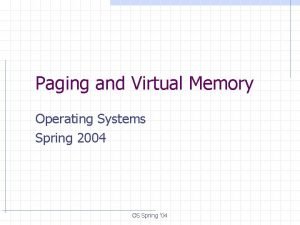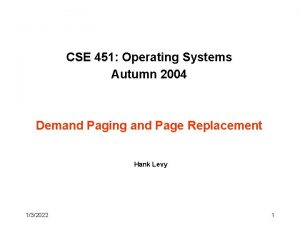Paging Adapted from 2004 2007 Ed Lazowska Hank







































- Slides: 39

Paging Adapted from: © 2004 2007 Ed Lazowska, Hank Levy, Andrea And Remzi Arpaci Dussea, Michael Swift

Virtual Addresses • Virtual addresses are independent of location in physical memory (RAM) that referenced data lives – OS determines location in physical memory – instructions issued by CPU reference virtual addresses • e. g. , pointers, arguments to load/store instruction, PC, . . . – virtual addresses are translated by hardware into physical addresses (with some help from OS) • The set of virtual addresses a process can reference is its address space – many different possible mechanisms for translating virtual addresses to physical addresses • In reality, an address space is a data structure in the kernel – Typically called a Memory Map

Memory mapping • Each region has a specific use – Loaded executable segments – Stack – Heap – Memory mapped files • Modifying the memory map yourself – mmap(void *start, size_t length, int prot, int flags, int fd, off_t offset); – munmap(void *start, size_t length);

Linux Memory Map • Each process has its own address space specified with a memory map – struct mm_struct; • Allocated regions of the address space are represented using a vm_area_struct (vma) – Recall: A process has a sparse address space – Includes: • Start address (virtual) • End address (first address after vma) – Memory regions are page aligned • Protection (read, write, execute, etc…) – Different page protections means new vma • Pointer to file (if one) • References to memory backing the region • Other bookkeeping

Memory map Linked list of memory regions assigned to valid virtual addresses

Memory map struct mm_struct { struct vm_area_struct *mmap; struct rb_root mm_rb; /* list of VMAs */ unsigned long task_size; unsigned long highest_vm_end; pgd_t * pgd; /* size of task vm space */ /* highest vma end address */ int map_count; /* number of VMAs */ unsigned long start_code, end_code, start_data, end_data; unsigned long start_brk, start_stack; unsigned long arg_start, arg_end, env_start, env_end; struct linux_binfmt *binfmt; mm_context_t context; };

VMAs struct vm_area_struct { /* The first cache line has the info for VMA tree walking. */ unsigned long vm_start; unsigned long vm_end; /* Our start address within vm_mm. */ /* The first byte after our end address within vm_mm. */ /* linked list of VM areas per task, sorted by address */ struct vm_area_struct *vm_next, *vm_prev; struct rb_node vm_rb; }; struct mm_struct *vm_mm; pgprot_t vm_page_prot; unsigned long vm_flags; /* The address space we belong to. */ /* Access permissions of this VMA. */ /* Flags, see mm. h. */ struct anon_vma *anon_vma; /* Serialized by page_table_lock */ /* Information about our backing store: */ unsigned long vm_pgoff; /* Offset (within vm_file) in PAGE_SIZE units */ struct file * vm_file; /* File we map to (can be NULL). */

Linked Lists

structs and memory layout fox fox list. next list. prev

Linked lists in Linux node fox list { } list {. next. prev } . next. prev fox list { } . next. prev

What about types? • Calculates a pointer to the containing struct list_head fox_list; struct fox * fox_ptr = list_entry(fox_list->next, struct fox, node);

List access methods struct list_head some_list; list_add(struct list_head * new_entry, struct list_head * list); list_del(struct list_head * entry_to_remove); struct type * ptr; list_for_each_entry(ptr, &some_list, node){ … } struct type * ptr, * tmp_ptr; list_for_each_entry_safe(ptr, tmp_ptr, &some_list, node) { list_del(ptr); kfree(ptr); }

Leveraging Page Tables • Virtual Addresses point to any Physical Addresses – Multiple PTEs can point to the same Physical Address • But each has its own permissions – Different processes can map the same physical memory • This is why fork() is fast and cheap – OS doesn’t have to allocate memory for children Read only Read only

Copy On Write • Copy on Write (COW) – On fork, both parent and child point to same physical memory • Make shared mappings read only for both child and parent – On write, page fault occurs • OS copies the physical page, updates page tables, and resumes process • Copy on Write (COW) allows both parent and child processes to initially share the same pages in memory • If either process modifies a shared page, only then is the page copied • COW allows more efficient process creation as only modified pages are copied

Read only Read only Process 1 Writes to Page C Read only Read/Write

Review: File I/O • File I/O System Calls – open, read, write, and close – Request OS to copy file data into process address space • But: File data is buffered (cached) inside the OS – Buffer cache: Collection of pages that stores file data – OS keeps buffer cache consistent with data on disk • Consistency Model? • So: File data is actually sitting in memory pages – Inside the kernel’s address space – Why not make them accessible to process address space?

Memory mapped Files • Instead of using open, read, write, close – “map” a file into a process’ virtual address space • Configure process pages tables to point to buffer cache pages • read()/write() become CPU loads/stores • OS must still manage buffer cache – What about very large files? – Standard I/O data is fetched/flushed on demand • Based on read/write system calls • Initially, all process PTEs are marked as invalid – CPU instruction accesses memory • Causes page fault, notifies OS of what part of the file the process wants to read • OS fetches disk data into memory • Updates PTE to point to page in buffer cache

Example Multiple Processes can map in the same file at the same time • File updates are seen immediately by each process with no OS interaction

Shared Memory Modern Method: void * mmap( void * addr, size_t length, // Length of data to map in int prot, int flags, int fd, // Open file descriptor off_t offset ); // Offset of data in file int munmap(void * addr, size_t length); Older Method (System V Shared memory) // Gets a handle to a shared memory region id’d via ‘key’ int shmget(key_t key, size_t size, int shmflg); // Maps shared memory region into local address space void * shmat(int shmid, const void * shmaddr, int shmflg); // Detaches shared memory region int shmdt(const void * shmaddr);

Memory Mapped IPC • mmap() maps in file data page stored in buffer cache – What happens if two processes are communicating heavily? • To OS it looks like a lot of file I/O • OS spends a lot of time flushing changes to disk • Special case: Shared memory purely for process communication – Shared data is not persistent – Don’t want to the OS to flush anything to disk – Linux provides a special file system for this • Tmpfs: Ram based file system • Stores temporary files backed by memory not disk

Demand Paging • Pages can be moved between memory and disk – process is called demand paging – OS uses main memory as a (page) cache of all of the data allocated by processes in the system • initially, pages are allocated in physical memory frames • when physical memory fills up, allocating a page in requires some other page to be evicted • Moving pages between memory / disk is handled by the OS – transparent to the application • except for performance

Moving Memory to/from Disk • When there is not enough memory for all our processes, the OS can copy data to disk and re use the memory for something else – Copying a whole process is called “swapping” – Copying a single page is called “paging” • Where does data go? – If it came from a file: • Unmodified: data is still consistent – Just delete the memory page • Modified (“dirty”): data is inconsistent – Data on disk must be modified – If it is raw memory allocated to a process • “Anonymous Memory”: (Heap, stack, etc…) • Swapped to dedicated storage device – Unix: Swap partition – Windows: Swap File

Demand paging • Think about when a process first starts up: – It has a brand new page table: all PTEs set as invalid • No pages are yet mapped to physical memory – When process starts executing: • Instructions immediately fault on both code and data pages • Faults stop when all necessary code/data pages are in memory • Only the code/data that is needed (demanded!) by process needs to be loaded • But, what is needed changes can over time

Page Faults • What happens to a process that references a VA in a page that has been evicted? – when the page was evicted, the OS sets the PTE as invalid and stores (in PTE) the location of the page in the swap file – when a process accesses the page, the invalid PTE will cause an exception (page fault) to be thrown – the OS will run the page fault handler in response • handler uses invalid PTE to locate page in swap file • handler reads page into a physical frame, updates PTE to point to it • handler restarts the faulted process • But: where does the page that’s read in go? – have to evict something else (page replacement algorithm) • OS typically tries to keep a pool of free pages around so that allocations don’t inevitably cause evictions

Data movement during swap operation

Swapping Approach • When should the OS write pages to disk to free memory? • Swap Daemon (a kernel thread) periodically wakes up and scans pages – Runs clock algorithm or adjusts working set sizes – Moves pages from “active” list – in use to “inactive list” – candidate for eviction • On Demand Paging – Swap out only when memory is needed • Worse case scenario: – Out Of Memory (OOM) Killer – Cannot swap out enough memory in time – So kill a random process to take its memory

Evicting the best page • OS must choose victim page to be evicted – Goal: Reduce the page fault rate – The best page to evict is one that will never be accessed again • Not really possible… • Belady’s proof: Evicting the page that won’t be used for the longest period of time minimizes page fault rate

Belady’s Algorithm • Find page that won’t be used for the longest amount of time – Not possible • So why is it here? – Provably optimal solution – Comparison for other practical algorithms – Upper bound on possible performance • Lower bound? – Depends on workload… • Random replacement is generally a bad idea

FIFO • Obvious and simple – When a page is brought in, goes to tail of list – On eviction take the head of the list • Advantages – If it was brought in a while ago, then it might not be used. . . • Disadvantages – Or its being used by everybody (glibc) – Does not measure access behavior at all • FIFO suffers from Belady’s Anomaly – Fault rate might increase when given more physical memory • Very bad property… • Exercise: Develop a workload where this is true

Least Recently Used (LRU) • Use access behavior during selection – Idea: Use past behavior to predict future behavior – On replacement, evict page that hasn’t been used for the longest amount of time • LRU looks at the past, Belady’s looks at future • Implementation – To be perfect, every access must be detected and timestamped (way too expensive) • So it must be approximated

Approximating LRU • Many approximations, all use PTE flags – x 86: Accessed bit, set by HW on every access – Each page has a counter (unused PTE bits) – Periodically, scan entire list of pages • If accessed = 0, increment counter (not used) • If accessed = 1, clear counter (used) • Clear accessed flag in PTE – Counter will contain # of iterations since last reference • Page with largest counter is least recently used • Some CPUs don’t have PTE flags – Can simulate it by forcing page faults with invalid PTE

LRU Clock • Not Recently Used (NRU) or Second Chance – Replace page that is “old enough” • Arrange page in circular list (like a clock) – Clock hand (ptr value) sweeps through list • If accessed = 0, not used recently so evict it • If accessed = 1, recently used – Set accessed to 0, go to next PTE • Problem: – If memory is large, “accuracy” of information degrades

N Chance clock • Basic Clock only has two states – used or not used • Can we add more? – Answer: Embed counter into PTE • Clock hand (ptr value) sweeps through list – If accessed = 0, not used recently • if counter = 0, evict • else, decrement counter and go to next PTE – If accessed = 1, recently used • Set accessed to 0 • Increment counter • Go to next PTE

Allocation of Pages • OS must allocate physical memory to competing processes – What if a victim page belongs to another process? – Replacement algorithms can take this into account • Fixed space algorithms – Each process is given a limit of pages it can use – When it reaches its limit, it replaces from its own pages – Local replacement: some process may do well, others suffer • Variable space algorithms – Processes’ set of pages grows and shrinks dynamically – Global replacement: one process can ruin it for the rest • Linux uses global replacement – But Containers allow local replacement

2 nd Chance FIFO • LRU Clock is a global algorithm – It looks at all physical pages, from all processes – Every process gets its memory taken away gradually • Local algorithms: run page replacement separately for each process • 2 nd Chance FIFO: – – – Maintain 2 FIFO queues per process On first access, pages go at end of queue 1 When the drop off queue 1, page are invalidated and move to queue 2 When they drop off queue 2, they are replaced If they are accessed in queue 2, they are put back on queue 1 • Comparison to LRU clock: – Per process, not whole machine – No scanning – Replacement order is FIFO, not PFN – Used in Windows NT, VMS

Working Set Size • The working set size changes with program locality – During periods of poor locality, more pages are referenced – Within that period of time, the working set size is larger • Intuitively, working set must be in memory, otherwise you’ll experience heavy faulting (thrashing) – When people ask “How much memory does Firefox need? ” • Really asking: “what is Firefox's average (or worst case) working set size? ” • Hypothetical algorithm: – Associate parameter “w” with each process • # of unique pages referenced in the last “t” ms that it executed – Only allow a process to start if it’s “w”, when added to all other processes, still fits in memory • Use a local replacement algorithm within each process (e. g. clock, 2 nd chance FIFO)

Working Set Strategy • The working set concept suggests the following strategy to determine the resident set size – Monitor the working set for each process – Periodically remove from the resident set of a process those pages that are not in the working set – When the resident set of a process is smaller than its working set, allocate more frames to it • If not enough free frames are available, suspend the process (until more frames are available) – ie: a process may execute only if its working set is in main memory

Working Set Strategy • Practical problems with this working set strategy – Measurement of the working set for each process is impractical • Necessary to time stamp the referenced page at every memory reference • Necessary to maintain a time ordered queue of referenced pages for each process – The optimal value for D is unknown and time varying • Solution: rather than monitor the working set, monitor the page fault rate!

Page Fault Frequency Strategy • Define an upper bound U and lower bound L for page fault rates • Allocate more frames to a process if fault rate is higher than U • Allocate less frames if fault rate is < L • The resident set size should be close to the working set size W • We suspend the process if the PFF > U and no more free frames are available
 Ed lazowska
Ed lazowska Martin hank
Martin hank Social psychology crash course
Social psychology crash course Hank webber
Hank webber Hank robb
Hank robb Hank streeter
Hank streeter What is prace
What is prace Heres hank
Heres hank How have plants adapted to the rainforest
How have plants adapted to the rainforest In what ways have the highland maya adapted to modern life?
In what ways have the highland maya adapted to modern life? Behavioral adaptations of zebras
Behavioral adaptations of zebras Best brother quotes
Best brother quotes This passage is adapted from jane austen
This passage is adapted from jane austen Spermopsida plants
Spermopsida plants Xerophytic plants diagram
Xerophytic plants diagram Adapted from the internet
Adapted from the internet How are red blood cells adapted
How are red blood cells adapted The outsiders adapted for struggling readers
The outsiders adapted for struggling readers Birds in the chaparral biome have adapted to living
Birds in the chaparral biome have adapted to living Gallant
Gallant Adapted with permission from
Adapted with permission from Number synoynm
Number synoynm Sausage shaped organelles
Sausage shaped organelles 5 adaptive features of camel
5 adaptive features of camel Facebook graph api paging
Facebook graph api paging Segmented/demand paged memory allocation
Segmented/demand paged memory allocation Demand paging
Demand paging Segmentation and paging
Segmentation and paging Shared pages
Shared pages Paging
Paging Tlb paging
Tlb paging Paging simulation
Paging simulation Secondary storage
Secondary storage Multilevel paging in os
Multilevel paging in os Backup and recovery techniques
Backup and recovery techniques Memory paging
Memory paging Demand paging in virtual memory
Demand paging in virtual memory Paging wireless communication
Paging wireless communication Performance of demand paging
Performance of demand paging Comp3500
Comp3500



